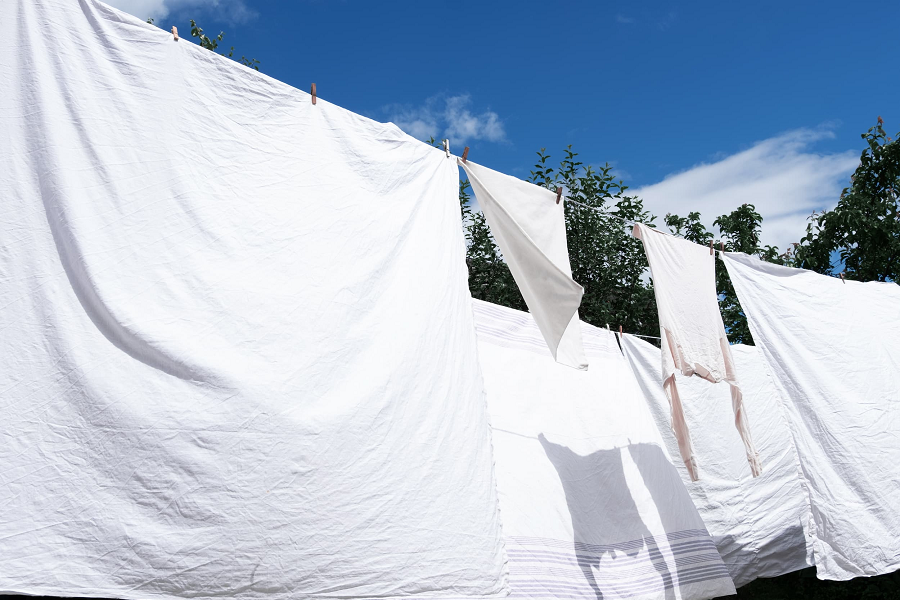How to care for cotton fabric
Most of us have cotton clothing or bed linens in our homes, to the point where it’s such a common fabric that we often don’t think about how to take good care of it the way we might if it were something more unusual like silk or leather. But cotton has needs just as any material does, and making sure you’re doing all the right things for your cotton items can help them to last as long as possible.
How to take care of cotton clothes
As with any other fabric, there are general rules to adhere to when it comes to looking after cotton. However, to get the very best results, it’s a good idea to take advice tailored to the specific item you want to care for - and fortunately, it’s easy to find. All you need to do is locate the garment care label, usually found on the interior of your clothing, and pay attention to the laundry care instructions and symbols printed on it.
Got a whole load of laundry to do and not enough time to check the labels on each item? Don’t worry. We’ve done the research and put together rough guidelines for washing, drying, ironing and storing cotton clothing below.
Washing cotton clothes
Cotton is typically a reasonably low maintenance fabric to wash, as it’s suitable for machine washing. Make sure to separate items into whites, lights and darks to avoid colour-running, then wash them at a cold temperature of 30°C. You can wash at a higher temperature if the garment is heavily soiled, but keep in mind that the more often you wash at a high temperature, the more likely it is that the garment will become wrinkled and may shrink.
Bed linens and undergarments can be washed at a higher temperature to kill off any germs and bacteria that have built up. For this purpose, 40°C is usually sufficient, but if you’re especially concerned about germs or someone in the household has been ill, wash at 60°C instead.
In general, where stains are involved, it’s best to pretreat the stains before putting the item in the washing machine. Detergent will usually work for this, depending on the stain, and if it’s particularly stubborn, you may find it helpful to hand wash the item on its own first, then put it through the washing machine for another clean.
Drying cotton clothes
Once your clothes are clean and sparkling, it’s time to dry them. Ideally, air drying is best to avoid the heat of a tumble dryer which can cause wrinkling and shrinkage. However, it’s good to be aware that direct sunlight can bleach the colour out of cotton clothes. This can make whites look brighter, but for coloured clothing, it may be better to hang them out of direct sunlight for the best results.
If air drying isn’t an option, or it’s taking too long to dry thicker items such as towels, then you can also use the tumble dryer. Put it on the lowest heat setting to reduce the risk of malformation. If possible, it can be a good idea to half dry your cotton items in the dryer, then let them air dry the rest of the way. That way, you get the best of both worlds.
Ironing cotton clothes
Want to make sure your items are crease-free? The good news is, you can iron most cotton garments. As always, check the garment care label to be sure, but the majority of cotton items can be ironed on a low heat. To avoid damaging visible areas, always iron the inside of the item. You can also use a pressing cloth between the iron and the fabric to take the brunt of the heat.
Top tip! In a pinch, a cotton garment can be hung up in a steamy bathroom to remove the wrinkles. If this is a no go, then put the garment on and lightly mist water onto the wrinkled areas before stretching the fabric with your hands. This should help to smooth out the appearance of your cotton clothing.
Storing cotton clothes
Once you’ve ironed out the wrinkles in your cotton garments, you’ll want to store them in the right way to avoid wrinkling them all over again. Cotton shirts can be hung with hangers in the wardrobe, and cotton trousers can too if you have trouser hangers. If you don’t, then loosely folding them will help to avoid creases while keeping them neat and tidy.
If you intend to store your cotton items for the long term - for example, if you store away your winter wardrobe during the summer months and vice versa - then it’s best to steer clear of airtight containers. Although these can help to keep pests and dust at bay, cotton is a natural fibre that needs to breathe to stay in the best condition. Additionally, storing cotton items in a cool, dry and dark place should help to avoid discolouration and malformation until you next come to wear them.
Copyright © 2025 Chums
PayPal Representative Example:
Representative 23.9% APR (variable) Purchase interest rate 23.9% p.a. (variable) Assumed Credit limit £1,200. PayPal Credit and PayPal Pay in 3 are trading names of PayPal UK Ltd, 5 Fleet Place, London, United Kingdom, EC4M 7RD. Terms and conditions apply. Credit subject to status, UK residents only, Chums Ltd acts as a broker and offers finance from a restricted range of finance providers. PayPal Pay in 3 is not regulated by the Financial Conduct Authority. Pay in 3 eligibility is subject to status and approval. 18+. UK residents only. Pay in 3 is a form of credit. Check if affordable and how you will repay. May make other borrowing more difficult or expensive. See product terms for more details.




